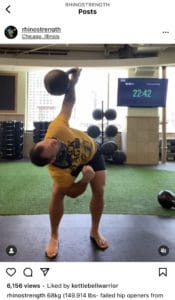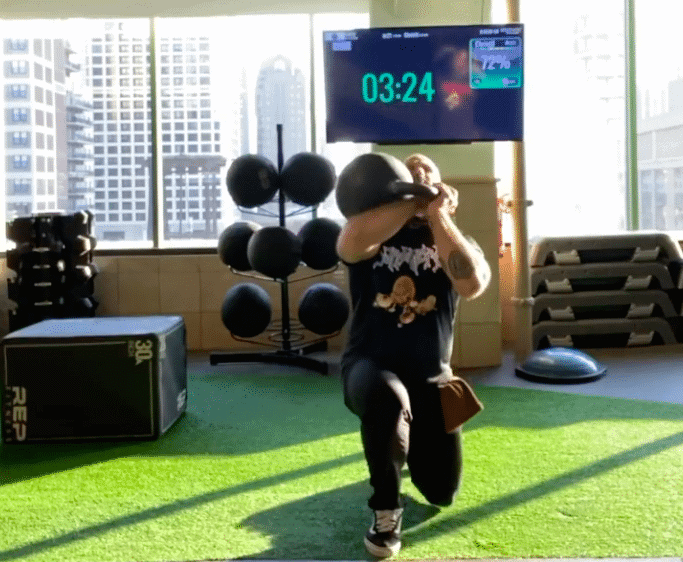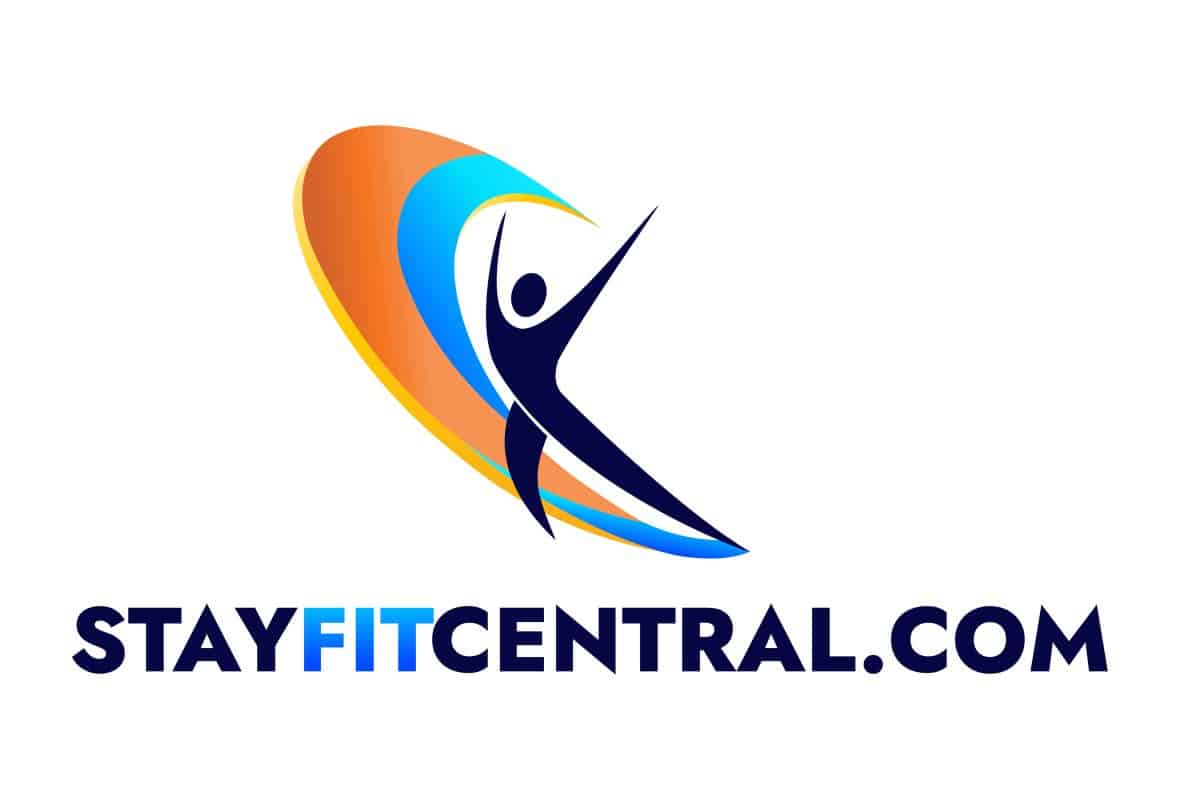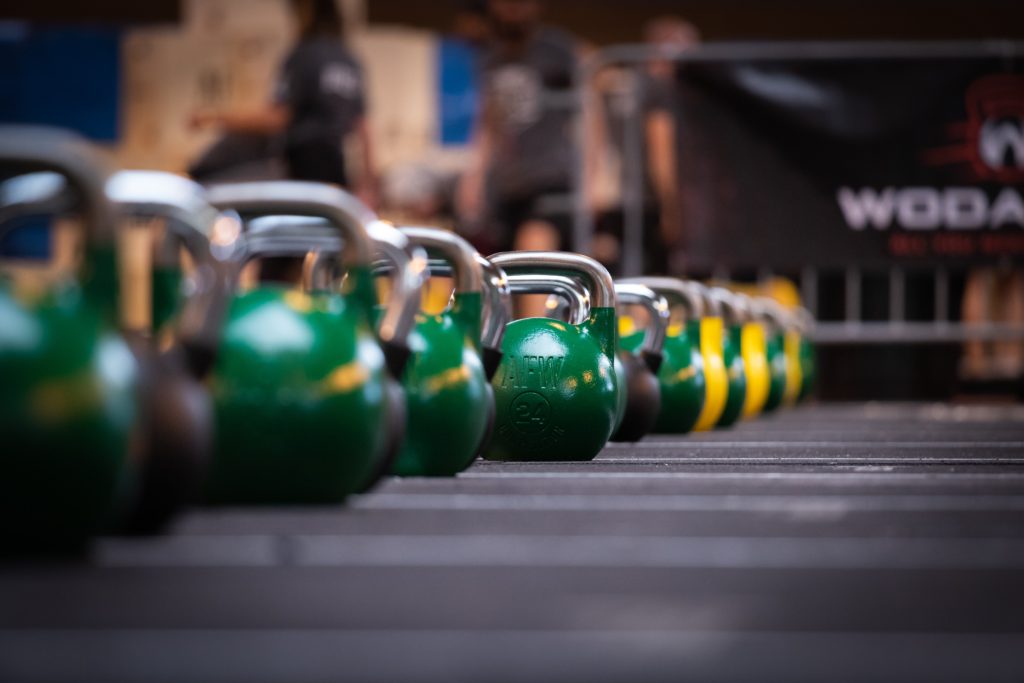Interviews
Steven Koontz – Chicago Kettlebell Trainer
Do a search on Instagram for a kettlebell trainer and you get over 17,000 results. The same search on Google returns millions more. With this many results, it’ll take forever for you to find the one that’s best for you. This makes finding the right one for you tricky. I wrote this article to help. I’ve done the research and found Steven Koontz (@rhinostrength), a Chicago based kettlebell trainer.
I’ve followed Steven on Instagram for 2 years. I watch every video he posts and always learn and get inspired to push myself when I train. Whether you want to get stronger, fitter, faster, or build more muscle he can help you out.
Steven’s style of kettlebell training
Many kettlebell coaches focus on swings, cleans, snatches and presses. These exercises are great and train all the muscles in your body but are still limited by the fact they don’t mimic all the ways we move.
The first thing I noticed and really liked about Steven’s work is that he doesn’t do this. He includes exercises that have you move throughout every plane of movement so you’re stronger not just when you squat or press but also when you need to rotate or move laterally.

If you aren’t familiar, there are three planes of movement. I’ve listed each below with example exercises. Knowing them
will help you understand the importance to the way Steven has people train..
- Frontal – exercise that have you move to the side such as lateral raises, lateral lunges, and side planks.
- Sagittal – forward and backward movements like kettlebell swings, lunges, biceps curls.
- Transverse – rotational exercises like the bent press, Russian twists, and figure 8s.
Additionally when you check out Steven’s IG account you’ll see he’s not just doing mobility exercises with light weights. He knows how to get strong in every plane too.
Here’s some of the lifts he’s posted to his account to show you what I mean.
- KB pistol squats with a swing/kettlebell flip between every rep with 123.5 lbs (56 kg).
- Single KB windmill/overhead squat/reverse lunge complex with 150 lbs (68 kg).
- Kettlebell skater squats, a version of 1 legged squat with 150 lbs (68 kg).
- Lateral lunges with 203 pounds (92 kg).
- Side planks with a 105 KB (48 kg) held overhead.
Ladies, don’t think his style of training is for men only. Check out to see his girlfriend’s account at @kettlekells Steven trained her for a while, helping her on the path to getting super strong. Her videos on IG demonstrate how strength training helps women become strong and lean, not bulky and musclebound.
Below is a Q&A session I recently did with Steven to learn more about his kettlebell training philosophy.
Hey Steven. So, how did you get into strength training?
You know, I never played organized sports. I skateboarded and played music all my life. So, like, the whole jock competing against everyone else in life wasn’t my thing.
So that’s kind of why I got into bodybuilding instead, it’s more of an artistic approach to physical well being than other sports.

When did you decide to become a kettlebell trainer?
I toured in a band for 10 years, as a drummer. And then I moved from California to Chicago. And when I moved here, I was broke. So I started working as a kettlebell trainer in Chicago.
How did you get into kettlebell training in Chicago?
When I started working at a gym there was this guy there who I saw as an older brother and mentor, he pulled me aside and said you should do kettlebells. I think you have the body to do old school style training with them. So from then on, I was getting on it with kettlebells.
I started with the Strong First kettlebell training certifications. I know this is going to sound very pompous but I didn’t train for it at all. I just walked in and did all the tests, including the snatch test.
From there I fell in love. I liked the simplicity of kettlebells. It was the antithesis of the bodybuilding stuff I was doing before. You know, isolating muscles, training for hypertrophy. Kettlebells are the opposite of that which left me pretty blown away.
So, I practiced more and more. Just like I would skateboarding. After a while I started getting bored just doing the Strongfirst/hardstyle swings, get ups, and presses. So I started experimenting.
I mean, I like Pavel’s stuff a lot. It changed the foundation of my training. But I’m not gonna lie, I think a lot of it is a little dogmatic. I think it holds a lot of things back. If it’s for you, it’s for you, you know? But I felt like a lot of their standards were just too easy.
Take the Simple And Sinister program – 10 Turkish Get Ups in 10 minutes and 100 swings in 5 minutes – it’s what they really push. I think of it as a warm up. Not a workout. I do it with a 48 kg kettlebell and it’s easy for me.
That’s why I started kind of expanding my training. I like and respect Strong First but I need other challenges.
What benefits do your clients notice first from kettlebells? What do they think about training in multiple planes for the first time?
That’s a good question. I really like that question. So I’m going to talk a little bit about that. I’ve been a trainer for 10 years, and I’m pretty good at my job, I was the number one trainer in the company for Equinox, and then I’m number 20, at my current company. Not that it means anything. But I have learned that there’s an art when it comes to retention. You have to get people to buy into the program.
One of the things that I think makes the light bulb go off for my clients is that they aren’t in pain like they were before training with me.
It’s not so hard to beat the crap out of somebody with a hard workout. It’s hard to make somebody better. And so the first thing is, you know, all of a sudden, they’re moving, they’re moving, and they realize, holy sh*t, I don’t have any pain.
This is after, you know, years of chronic pain, they feel like they are moving better and feeling better. I think that’s where the value of me and what I’ve taught them comes in. They’re again able to do everyday activities without being obliterated afterward.
But, you know, back to the training in different planes, it’s also a bodybuilding thing. You know, like, Arnold Schwarzenegger always talked about training different planes of motion. The world is not front backwards and side to side. It’s, it’s a circle, you know. And again, Louie Simmons even talks about this kind of stuff. You know these bodybuilders do bench squats, bench squat deadlifts, squat deadlifts, but why? Why are you doing this? There’s so much more to life than this, you know? And so I learned this stuff from bodybuilding. And, you know, it’s kind of been the key to everything.
Do your clients do the majority of their workouts with kettlebells?
Sure, I think so. Now, if you asked me three years ago, I would say no. But I guess a better answer is, it’s not all kettlebells. But we’re never on a machine. Maybe the leg press. You know, maybe the leg press because I think the leg press is pretty valuable. You know, are you doing calf raises? I think so. I’m a huge fan of calf raises. Especially for knee pain and just general glute activation. But I’ll do… I’m always in the gym working on this. I just have kettlebells, TRX, bands and I like cables a lot too. But again, especially for bodybuilding. Those cables are awesome. But yeah, I don’t really ever stray away from that kind of training.
Yeah, you know, I tried a Bulgarian bag. I love it but haven’t done enough of it to train regularly with it. And to teach it, you know, is absolutely, awesome. I love the sand. I love that sand action. It’s f*ck*ng cool. Bulgarians, I guess like a U shaped kind of sandbag. Again, I think the Bulgarian bags are more rotational.
Mentally it helps me. I would say it’s mainly mental and I also just enjoy it. Also, mentally I’m a much better person if I work out every day.
You know, I used to do Arnold Schwarzenegger workouts. Where I would do upper body on Monday, lower body all Tuesday, Wednesday would be rotational exercises, shoulders and arms. Then you repeat the workouts. Thursday is upper body, Friday lower body, Saturday rotational exercises, shoulders, and arms. I’d take Sunday off.
I’m 37 and I can’t do that anymore. I often work, you know, 8 to 12 hours a day so that makes those workouts too hard.
Now what I’m doing on Monday is, I’m doing upper body, bodybuilding. Tuesday, is rotational/cardio type stuff. Wednesday is lower body. Thursdays are the same as Tuesday, just different exercises, Friday shoulders and arms. Saturday is again, like Tuesdays and Thursdays. I do cardio everyday too.
Any tips for others who want to give this training frequency a try?
I think Pavel Tsatsouline is a genius here. He says, I’d never worked more than 60% of my max. If I decide to go heavy, right, like the heaviest I’ve ever swung is 480 lbs. I loaded the plates on and performed 5 reps with 480 pounds.
Since that’s my 5 rep max, I only need to use a 202.4 lbs (92 kg) kettlebell. A 106 lb (48 kg) kettlebell is what I use for single arms swings and cleans. So you see, I never really go heavy compared to my max strength.
So, my advice for training every day is listen to your body. Don’t be afraid if you’re feeling good one day to go heavier or do more sets and/or reps that day.
I feel good training this way and so do my clients.
You don’t have to worry about grinding yourself or clients into the ground either.
Yeah, exactly. If you’re going to work out everyday, stay in your 50% rep range and evolve.
When you do need to push really hard and go heavier, it’ll happen. That’s the Pavel Tsatsouline mentality. He’s 100% right about it too. Working out more often at 50-60% of our max effort makes you strong and ready for harder training.
One last thing about training every day. It goes along with what Pavel says. You just gotta keep training regularly. This girl I know, who’s a doctor of physical therapy, says strength takes a long time to build. Mobility even longer. So, the more repetitions or practice you do, the stronger you’ll get.
What do you do for cardio?
I wish I was doing more like running and stuff. I used to run all the time. But again, my body type is not really made for running. But, I wish I ran. What I do is ski erg or the Airdyne calorie bike.
I call my cardio workouts Squid Games where you’re going to do it in 15 minutes or you’re gonna die. This is my new thing. These workouts are: 1000 meters on a rowing machine, 1000 meters on the ski erg, and 100 calories on the bike. I do that in 15 minutes.
I just now upped it for an even tougher and better workout. I now do 1000m ski erg, 1000m rowing, and 100 calories on the Airdyne. I also added 100 snatches. I do it in 20 minutes.
Here’s another cardio workout of mine. I did this today. I put 30 minutes on the clock, did 100 bent presses on each side, single arm swings, double handed swings all with a 132 lb (60 kg) kettlebell. I finished it with mace swings (http://www.trainingroomonline.com) which are also called goddess swings.
This workout has me moving in different planes of motion and opening up my body. It definitely cranks your heart rate up !
Lots of people promote super high rep kettlebell swing workouts? Like Dan John’s 10,000 swings in a month program. Have you ever done that? What do you think about this style of workout?
I know what you’re talking about. I like his stuff in general but I think that workout is not good.
The 10,000 swing workout seems like clickbait to me. Here’s why. So you say I’m gonna do 333 swings a day. Okay, but why? Unless you’re a Giro Sport kettlebell athlete. I get why they’re doing it. It’s their sport to do as many reps you can in a set time. The reason I think people are doing that workout is because they have no focus.
It’s not hard to beat the sh*t out of yourself or someone else during a workout doing super high rep sets of swings or whatever. What is hard, is to make someone better. That’s kind of my motto with training. It comes down to how much better are you actually getting. It’s a cool way to work out once in a while, but I don’t do it all that much.
I also read something where Dan said you should never go heavier than the 52 lb (24 kg) Turkish getup (https://youtu.be/0bWRPC49-KI) and I was like, bro, you’re just wrong. If I did 24 kg get ups I would not change. I would not get stronger. I would not get more mobile. I would just be like, pretty much falling on the ground. You know? You have to focus on getting better.
If you had to pick 2 kettlebell exercises as your favorite, what would they be?
I think kettlebell swings are most important. Other than that I would say Turkish get ups and bent presses. I do them 2-3 times a week, never going lighter than the 106 lb (48 kg) kettlebell.
One way I do this workout is to first do kettlebell bent presses for sets of 3 reps. That’s 3 reps on the right and 3 reps on the left. I’ll do that for 4-5 sets. I follow this with get ups. I really like doing these 2 exercises because they make my body move really well.
They cover all the bases in terms of training your entire body.
Yeah, I want everyone to try bent presses to see how good you feel after. They make my whole body feel awesome, and that’s what I want. I want to feel good.
I always tell my clients, the workout should give you more than it takes. You should leave feeling better than you did when you came in.
I see from your IG account you’ve lost a lot of excess body fat recently and got really lean. Congratulations. I know how hard that is to do.
Also, I really struggle with my weight. The leanest I got was 214 lbs. Now I’like 225-228 lbs. I want to be a skinny legend. I don’t care at all about lots of muscle. I want to get as lean as I can.
One of the things I realized is that I never ever stop dieting if I want to be lean. I have to always be in somewhat of a deficit. Like I have to measure my food and know all my macros. It sucks.
Thanks Steven. You’ve given us a lot of information and new ways to think about kettlebell training. If anyone reading this wants a kettlebell trainer in Chicago, make sure you look Steven up.
- Why You Should Buy An AI Personal Trainer - April 5, 2024
- Before You Buy –Features Personalized AI Workouts Require - March 20, 2024
- AI Workouts Have Come To The Super Bowl - February 7, 2024

